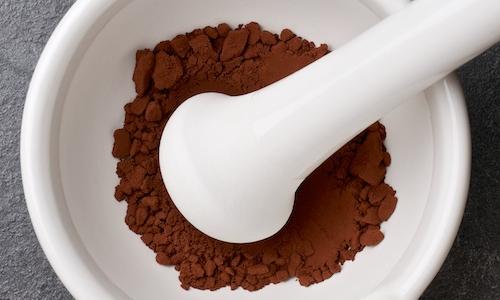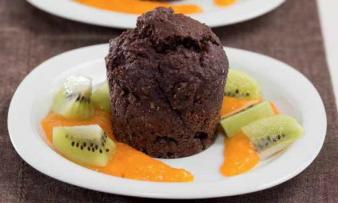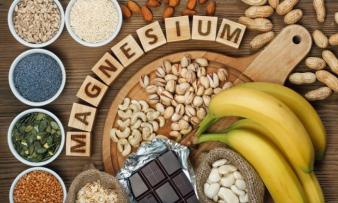Table of contents
Unsweetened cocoa powder ( organic ) is the dry mass that is produced after processing fermented cocoa beans in addition to cocoa butter . It has many valuable ingredients that are retained, especially when roasting is omitted ( raw ).
Use in the kitchen
The most famous use of cocoa powder is to prepare the drink called cocoa (pronounced [kaˈka͜u] or [kaˈkaːo]) or '(hot) chocolate'. For a vegan version, mix the cocoa powder with plant-based milk (e.g. oat milk ) and, if necessary, with a little sugar or other sweeteners (e.g. agave syrup , dates ). Unsweetened cocoa is much healthier. As a drink, cocoa tastes cold, warm or hot. If the fat content is higher, cocoa powder does not dissolve as well in cold drinks.
Cocoa powder is also suitable for making all kinds of chocolate products such as ice cream, creams, sauces, spreads and puddings (e.g. raw chocolate pudding with avocado and banana or chia ). Raw cocoa powder without sugar is particularly popular as a baking ingredient: This is why it is often referred to as 'baking cocoa'. The powder gives a cocoa-based taste to a wide variety of cakes, muffins, brownies and cookies. It can also be used to refine vegan waffles, crêpes, semolina pudding and porridge.
Unsweetened cocoa powder, as a spice, gives cooked dishes a slightly chocolatey note. It goes well with hearty dishes such as chili sin carne, vegan goulash and spaetzli pans. We present a particularly recommended recipe with cocoa powder here: stuffed peppers with mushroom and walnut filling and tomato sauce .
Is cocoa powder raw? Unsweetened cocoa powder can be eaten raw. It is important to note that cocoa powder is often made from roasted cocoa beans. Whether cocoa is raw depends on the temperatures during production, which vary from country to country: in Europe, temperatures < 42 °C are considered raw, in many places in the USA 45-47 °C. However, temperatures over 50 °C can occur during the fermentation and drying of the cocoa beans in the sun, and controls are difficult here.
Is cocoa powder vegan? Unsweetened cocoa powder is purely plant-based. In ready-made cocoa mixes, the vitamin D often contained in them may be of animal origin (e.g. from wool fat) in addition to milk.
Vegan recipe for porridge with cocoa powder
Ingredients (for 2 people): 70 g oat flakes , 350 ml oat milk , 150 ml water , 1 tbsp unsweetened cocoa powder (organic), ½ tsp cardamom (ground), ½ tsp cinnamon (ground) . Topping ideas: 2 tbsp granola, 1 banana , 2 tsp hemp seeds , 2 tsp cocoa nibs , a handful ofblueberries .
Preparation: For this chocolate porridge, put the oat flakes in a pan. Mix the oat milk and water, but keep about 50 ml of the oat milk-water mixture separately. Stir the cocoa powder into this 50 ml until there are no more lumps, then add the cardamom and cinnamon. Add the majority of the oat milk-water mixture (about 450 ml) to the oat flakes in the pan and bring to the boil while stirring. Then cook the porridge for about 10 minutes; only then add the liquid cocoa-spice mixture and simmer for another 2 minutes. It is important to stir constantly during the cooking process so that the porridge does not burn. Divide the chocolate porridge into two bowls, arrange with the desired toppings and serve.
Vegan recipes with cocoa powder (unsweetened) can be found under the note: " Recipes that have the most of this ingredient ".
| Not only vegans or vegetarians should read this: Vegans often eat unhealthily. Avoidable nutritional mistakes . |
Purchasing - Storage
Unsweetened cocoa powder is available all year round in well-stocked supermarket branches such as Coop , Migros , Denner , Volg , Spar , Aldi , Lidl , Rewe , Edeka , Billa , Hofer etc. Many cocoa powders that you can find in stores (including unsweetened ones) are made from roasted cocoa beans. This means that they are not considered raw food. However, you can buy the powder in many organic supermarkets (e.g. Alnatura , Denn's Biomarkt ), health food stores, delicatessens and online shops in organic quality (organic) and as raw food. So always pay attention to the information on the packaging when buying cocoa.
The availability of unsweetened cocoa powder varies depending on the size of the store, catchment area, etc. If you are interested, click on our recorded food prices for the DA-CH countries (above under the ingredient image). There you will find current prices from various supermarkets and their price development.
Storage tips
Cocoa powder should be stored in a cool, dry place and tightly sealed. A screw-top jar or a tightly sealed container is ideal for storage. Since cocoa powder quickly absorbs other odors, it should not be stored near tea or coffee. The cocoa powder will last for several months.
Ingredients - Nutritional values - Calories
The energy content of 100 g of unsweetened cocoa powder is 228 kcal. These come primarily from carbohydrates (58 g/100g), of which 1.8 g is sugar. With 20 g of protein and 14 g of fat per 100 g, unsweetened cocoa is high in protein and fat. Dietary fiber is also well represented at 37 g/100g - similar to carob powder (40 g/100g) and paprika powder (35 g/100g). 1
The amount of manganese in cocoa powder is 3.8 mg/100g, which is enough to meet your daily requirement even in small amounts. Oat flakes (3.6 mg/100g) and macadamia nuts (4.1 mg/100g) contain a similar amount of manganese. At 60 mg/100g, cloves contain more than 15 times as much manganese, but you only consume very little of the spices. 1
Unsweetened cocoa powder contains 499 mg of magnesium per 100 g, a similar amount to sea salt (501 mg/100g) and dried dill (451 mg/100g). With 700 mg of magnesium per 100 g , unshelled hemp seeds have a very high value of this element. 1
Unsweetened cocoa powder contains 0.29 g of tryptophan per 100 g, which is comparable to flaxseed (0.3 g/100g) and cashews (0.29 g/100g). Spirulina contains just over three times as much of this amino acid, at 0.93 g/100g. 1
The complete ingredients of cocoa powder (unsweetened), the coverage of the daily requirement and comparison values with other ingredients can be found in our nutrient tables. In the article Nutrients explained you will get a detailed insight into the topic.
Effects on health
Does cocoa powder have nutritional value? Although cocoa powder is not exactly low in fat, it does contain some substances that have a positive effect on health. Cocoa powder contains flavanols (secondary plant substances, a subgroup of flavonoids), which have blood pressure-lowering properties, at least in the short term. Flavanols increase the elasticity of blood vessels and can reduce the risk of cardiovascular disease. 2 The flavanol content depends very much on the origin of the cocoa beans and the processing of the raw cocoa. In addition, the flavanol intake is linked to the portion size. Cocoa flavanols have antioxidant activities. Consequently, it is assumed that cocoa has an immunomodulatory effect on infectious diseases and cancer. 3
Methylxanthines are also among the secondary plant substances contained in cocoa powder. Among them is caffeine, which improves neuroplasticity and protects neurons from dysfunction and degeneration. But the effect is often an interaction of several ingredients. It is assumed that a combination of various phytochemicals, including the flavonoids mentioned above (including the flavanol epicatechin), increases the ability to think. Experimental models have shown protection against strokes and Alzheimer's. 4
The results of experiments indicate a connection between the polyphenols (extracts) contained in cocoa and the relief of anxiety and depression. 5 However, other studies have found that higher chocolate consumption leads to depressive symptoms. 6 It is therefore controversial whether the consumption of cocoa - and in what quantities - really makes people happy. More detailed studies should clarify the clear connection.
The positive properties of cocoa powder depend heavily on the raw food quality (if the cocoa beans are not heated much above 40 °C during production).
Dangers - Intolerances - Side effects
Cocoa powder should be used unsweetened, but it is often consumed in the form of chocolate sweets that contain a lot of sugar and additional fat. The high fat and sugar content increases the risk of becoming overweight and the associated cardiovascular problems. 3
Dark chocolate can promote and worsen the development of acne when consumed regularly in normal amounts (in people with acne-prone skin). In the case of milk chocolate, the milk can further intensify the effect. 7
Cocoa powder contains caffeine and related substances such as theobromine. If the dosage is too high, it can cause migraine-like headaches, rapid heartbeat, tremors, hyperexcitability and sweating. 8 With normal consumption of cocoa powder and a low-purine diet, theobromine can help reduce the risk of kidney stones (crystallization of uric acid). 25
Depending on its origin, cocoa can be contaminated with the heavy metals cadmium or lead. Although the contamination is not considered problematic, there should still be interest in reducing such heavy metals in cocoa products. Cadmium and lead are suspected of causing kidney damage. 9
Although cocoa powder does not contain histamine, it does contain other biogenic amines that people with histamine intolerance do not tolerate well.
Folk medicine - natural medicine
In folk medicine, cocoa is used for infectious intestinal diseases, diarrhoea, asthma, dry coughs and to regulate the thyroid gland. 10
Between the 16th and 20th centuries, well over 100 uses of cocoa or chocolate as a medical treatment have been documented. Among these, three applications are the most common: to induce weight gain in emaciated patients, to stimulate the nervous system, and to improve digestion and elimination. 3
Ecological footprint - animal welfare
Different methods have been established for the cultivation of cocoa trees for commercial use. The trees either grow in monocultures, for which existing forests are often cleared to create enough space. Alternatively, there is agroforestry, in which cocoa trees grow in a system of other plants. This means they are not directly exposed to the sun and therefore require less water. Compared to monocultures, there is more potential for biodiversity here. 15
The ecological footprint in terms of the amount of CO 2 emitted for the production of cocoa powder depends on the cultivation method (organic or conventional cultivation), but also on the management (monoculture or agroforestry). Organic agroforestry produces the smallest amounts of CO 2 emissions compared to conventional agroforestry or the cultivation of cocoa trees in monocultures. 20 Overall, however, the ecological footprint is considered to be large due to the long transport routes from Africa or South America and the many production steps. 15 It is also important to note that the carbon stored in the trees is released during clearing and subsequent decomposition or combustion, which further worsens the ecological footprint. 21 It is difficult to understand under which type of management the cocoa trees are grown for the production of cocoa products. However, you can look out for the Rainforest Alliance certified seal. Companies with this certification are encouraged to plant more native trees on their land and promote regional agroforestry. Child labour can also be excluded through this seal (as is the case with Fairtrade ). 22
Cocoa powder has a poor water footprint: almost 16,000 liters of water are needed to produce 1 kg of cocoa powder. 14 This is similar to that of roasted coffee, but lower than that of cocoa butter . 23
When buying cocoa products, you should give preference to products that are as sustainable as possible. Organic logos indicate that the product is grown in an environmentally friendly way (pesticide-free) and that it is produced carefully, while fair trade seals indicate that it is a product produced under fair conditions and without child labor. Organic producers also do not use gassing during transport or alkalizing the cocoa mass (additives such as sodium carbonate, potassium carbonate and magnesium oxide, tartaric acid and citric acid are required - without any labeling requirement). 24
Animal protection - species protection
The deforestation of rainforests for cocoa plantations threatens many animals because it takes away their habitat. One example of particularly threatened animals are monkeys. The world's leading cocoa producer, Côte d'Ivoire, experienced a huge expansion of the cocoa agro-industry between 1961 and 2000. Much of this expansion took place at the expense of the jungle. The primates living there are suffering as a result and are showing worrying population declines. 16
Worldwide occurrence - cultivation
The Maya, Aztec and Inca peoples knew about the benefits of cocoa and attributed a special role to it from their own experience. The cocoa drink was reserved only for the select few, such as the ruler Moctezuma . The Spanish conqueror Hernán Cortés brought cocoa to Europe in 1528. 11
The cocoa plant is native to Central America, but is now cultivated in many other tropical regions. 12 Many plantations are located in the tropical rainforests of West Africa. The largest producers are Côte d'Ivoire, Ghana and Indonesia. 13
Industrial cocoa powder production
To produce cocoa powder, you need fermented cocoa beans , which are first cleaned and often roasted. This makes it easier to remove the shell from the cocoa kernel. The beans are then ground in cocoa mills. This creates a sticky cocoa mass. What is cocoa powder? To make cocoa powder, you have to extract the fat - the cocoa butter - from the cocoa mass using hydraulic presses. What remains is a press cake, which is then ground into cocoa powder. 17
Cocoa powder is categorised based on its cocoa butter content, among other things. The term for powder from which a lot of fat has been removed is 'highly deoiled' (at least 8% cocoa butter). Powder with a low level of deoiling has a higher fat content (at least 20%) and is more intense in flavour.
Many manufacturers add an additional step, namely alkalization (Dutching / Dutch Process). In this chemical process, the cocoa mass is treated with alkaline solutions of potassium carbonate or sodium carbonate, for example, before pressing. Such ingredients are not subject to labeling requirements. These solutions neutralize the acid content and reduce the bitter taste. The process is also intended to improve the solubility of the powder. Dark cocoa powder is alkalized and processed; untreated, natural cocoa powder is significantly lighter. 18
To obtain raw cocoa powder, the cocoa bean must have undergone a raw and as gentle as possible processing at very low temperatures (up to 42 or 47 °C, depending on the region).
Further information
Cocoa powder is obtained from the cocoa tree ( Theobroma cacao ), which belongs to the mallow family. The tree bears split capsule fruits. The contents of these split capsules are seeds, which are important for the production of cocoa powder.
Alternative names such
as cocoa powder (unsweetened) or cocoa powder without sugar are often also found under the name baking cocoa or pure or unsweetened cocoa.
In English, unsweetened cocoa powder is called unsweetened cocoa powder (not cacao powder).
Other uses
Cocoa can be found in some cosmetic products. It counteracts the formation of wrinkles and cares for stressed skin.
In addition, cocoa is becoming increasingly popular as a "drug" in certain party scenes. As a drink or pill (capsule), cocoa is supposed to make partygoers euphoric and sharpen their perception. However, the effect is subtle, which is why cocoa cannot really be described as a party drug. A placebo effect is also conceivable. 19
Bibliography - 25 Sources
| 1. | USDA United States Department of Agriculture. |
| 2. | Ried K, Fakler P, Stocks NP. Effect of cocoa on blood pressure. Cochrane Database Syst Rev. 2017;4:CD008893. |
| 3. | Katz DL, Doughty K, Ali A. Cocoa and chocolate in human health and disease. Antioxid Redox Signal. 2011;15(10):2779–811. |
| 4. | Camandola S, Plick N, Mattson MP. Impact of coffee and cacao purine metabolites on neuroplasticity and neurodegenerative disease. Neurochem Res. 2019;44(1):214–27. |
| 5. | Sokolov AN, Pavlova MA, Klosterhalfen S, Enck P. Chocolate and the brain: neurobiological impact of cocoa flavanols on "cogn." and behavior. Neurosci Biobehav Rev. 2013;37(10 Pt 2):2445–53. |
| 6. | Rose N, Koperski S, Golomb BA. Mood food: chocolate and depressive symptoms in a cross-sectional analysis. Arch Intern Med. 2010;170(8):699–703. |
| 7. | Vongraviopap S, Asawanonda P. Dark chocolate exacerbates acne. Int J Dermatol. 2016;55(5):587–91. |
| 8. | Baggott MJ, Childs E, Hart AB, et al. Psychopharmacology of theobromine in healthy volunteers. Psychopharmacology. 2013;228(1):109–18. |
| 9. | Abt E, Robin LP. Perspective on cadmium and lead in cocoa and chocolate. J Agric Food Chem. 2020;68(46):13008–15. |
| 10. | Apotheken.de Kakao. |
| 11. | Brücher H. Tropische Nutzpflanzen. Ursprung, Evolution und Domestikation. Springer Verlag: Berlin; 1977; 470-480. |
| 12. | Pahlow M. Das grosse Buch der Heilpflanzen. Gesund durch die Heilkräfte der Natur. Nikol Verlagsges. mbH: Hamburg; 2013; 451. |
| 13. | Pini U. Das Bio-Food Handbuch. Ullmann Verlag: Potsdam; 2014: 361-362. |
| 14. | Healabel.com The impact of cocoa powder. |
| 15. | Blog.wwf.de Schokolade und Umwelt: die dunkle Seite. |
| 16. | Bitty EA, Bi SG, Bene J-CK, Kouassi PK, McGraw WS. Cocoa farming and primate extirpation inside cote d’ivoire’s protected areas. Tropical Conservation Science. 2015;8(1):95–113. |
| 17. | Chemie-in-lebensmitteln.katalyse.de Gewinnung von Kakaopulver und Kakaobutter. |
| 18. | Fairafric.com Alkalisierung von Kakao. |
| 19. | Focus.de Neue Party-Droge erobert die Szene: Kakao. |
| 20. | Pérez-Neira D, Copena D, Armengot L, Simón X. Transportation can cancel out the ecological advantages of producing organic cacao: The carbon footprint of the globalized agrifood system of ecuadorian chocolate. Journal of Environmental Management. 2020; 276. |
| 21. | Melillo JM, Houghton RA, Kicklighter DW, McGuire AD. Tropical Deforestation and the global carbon budget. Annu. Rev. Energy Environ. 1996; 21:293-310. |
| 22. | Rainforest-Alliance. Rainforest Alliance-zertifizierter Kakao. 2022. |
| 23. | Mekonnen MM, Hoekstra AY. The green, blue and grey water footprint of crops and derived crop products. Hydrol. Earth Syst. Sci. 2011; 15:1577-1600. |
| 24. | Chemie-in-lebensmitteln.katalyse.de Gewinnung von Kakaopulver und Kakaobutter. |
| 25. | Costa-Bauza A, Grases F, Calvó P, Rodriguez A, Prieto RM. Effect of Consumption of Cocoa-Derived Products on Uric Acid Crystallization in Urine of Healthy Volunteers. Nutrients. 2018 Oct 16;10(10):1516. |











Comments